- Where is Kailash Parvat Located? Essential Insights into the Holy Mount Kailash (Kangrinboqe)
- Mount Kailash Parvat Location Unveiled: Everything You Need to Know about (kangrinboqe)
- Is Mount Kailash in China, India, or Nepal? In which country is Kangrinboqe peak?
- The Geography of Kailash Parbat: A Sacred Geological Wonder
- Mount Kailash Height and Elevation above Sea Level | Kangrinboqe peak height
- Mount Kailash (Kangrinboqe): The Sacred Mountain No One Has Ever Climbed
- Mountaineers and the Mystery of Kailash Parvat (kangrinboqe peak)
- History of Mount Kailash Parbat
- 10 Fascinating Facts About Mount Kailash
- How to Reach Mount Kailash
- Most Asked Questions of Mount Kailash Mansarovar
- Conclusion
Way out in one of Tibet's most remote corners stands a mountain that's been drawing people for thousands of years. Mount Kailash (Kangrinboqe peak) doesn't look like much at first, just another peak rising from the harsh landscape, but there's something about this place that gets to you.
Locals know it as Gang Rinpoche and Kangrinboqe, and while Mount Kailash's height reaches 6,638 meters (21,778 feet), it's not the tallest mountain around. However, height isn't what makes this place special, though.
The Mount Kailash location sits deep in Tibet's Ngari Prefecture, so far from civilization that just getting there becomes an adventure. It’s in the Gangdisê Range, where the landscape feels untouched.
Mount Kailash is located in the western region of the Tibetan Plateau, specifically in the Ngari Prefecture of the Tibet Autonomous Region, China. Its coordinates are approximately 31.0675° N latitude and 81.3119° E longitude. It is part of the Gangdise Shan (also known as the Kailash Range).
Hindus see it as Lord Shiva's sacred home, Buddhists treat it as holy ground, and the whole area carries an energy that's hard to describe.
People travel from every corner of the world to walk the Kailash Parikrama, a 52-kilometer trek around the mountain's base. This isn't your typical mountain hike because pilgrims believe it can wash away lifetimes of sins and bring them closer to enlightenment.
Some people come here for religious reasons, others are looking for something they can't quite put into words. When you stand in front of Mt Kailash, you realize this isn't just another Himalayan peak. Once you see it with your own eyes, you finally get why.
Mount Kailash Location? Kangrinboqe peak location
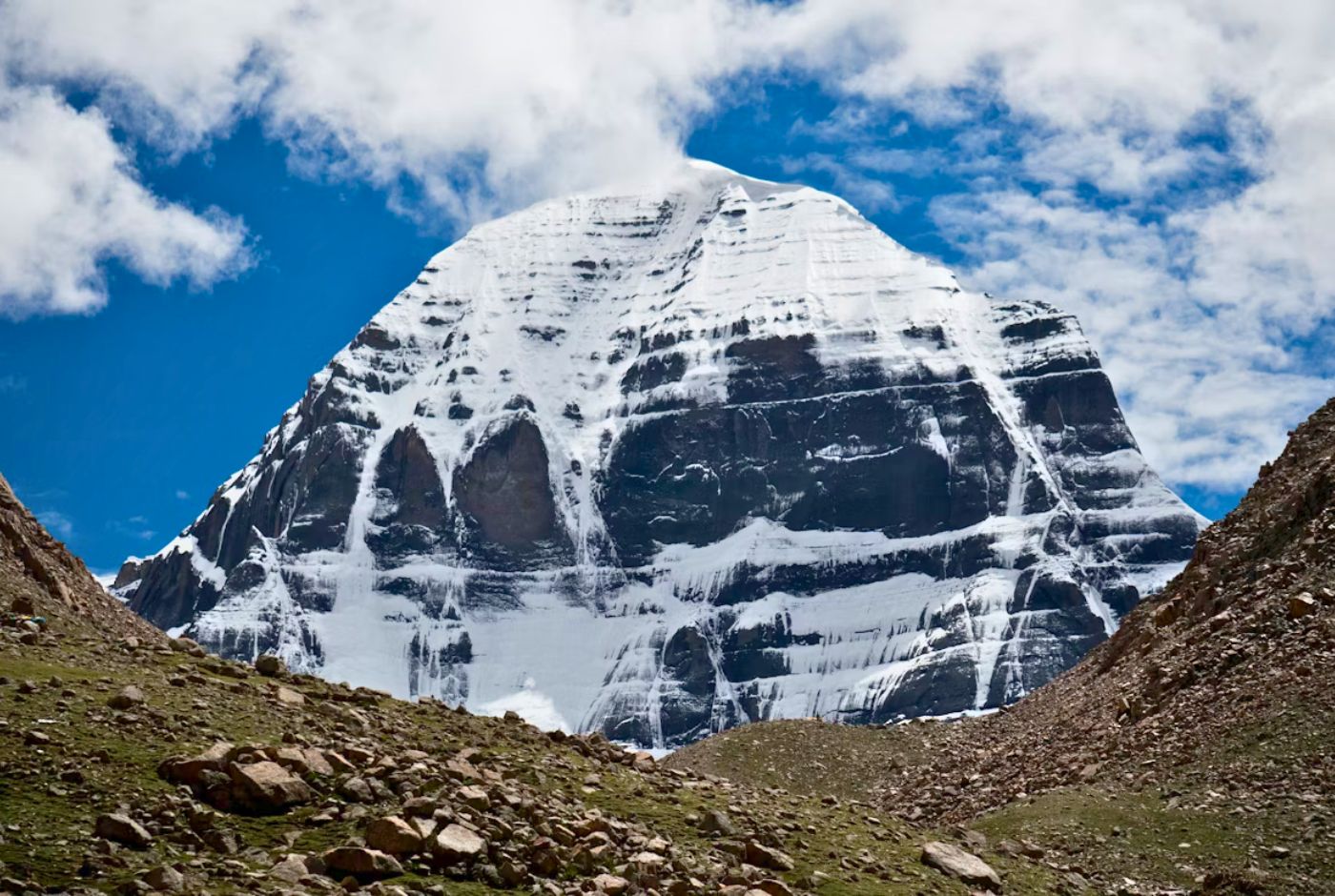
Where is Kailash Parvat Located? Essential Insights into the Holy Mount Kailash (Kangrinboqe)
Mount Kailash, also known as Kailas Parvat, is located in the Ngari Prefecture of the Tibet Autonomous Region of China. It is part of the Kailash Range, also known as the Gangdise Mountains, which is a subrange of the Trans-Himalaya. The mountain is situated in a remote western part of the Tibetan plateau, close to the borders of India and Nepal.
- Elevation / Height: Mount Kailash towers at 6,638 meters (21,778 feet) above sea level, also known as one of the most revered peaks in the region.
- Location: Kailash Parbat is situated in Burang County within the Ngari Prefecture of the Tibet Autonomous Region, China. This remote location of Mount Kailash adds to its spiritual appeal.
- Geographical Range: Mountain Kailash belongs to the Kailash Range (commonly called the Gangdisê Mountains), which forms part of the extensive Transhimalaya mountain system.
- Coordinates: You'll find Mount Kailash at 31°4′0″N, 81°18′45″E, one of the most spiritually significant locations on our planet
- Spiritual Significance: Four ancient faiths, including Hindu, Buddhist, Jain, and Bon, worship this remote peak with completely different stories. Despite their conflicting legends, all agree that Kailash holds power beyond our human understanding.
Sacred Names of Mount Kailash:
- Sanskrit: Kailāsa, known as the home of Lord Shiva
- Tibetan: Gang Rinpoche (translating to "Precious Jewel of Snow")
- Chinese: Gāngrénbōqí Fēng (冈仁波齐峰)
Climbing Status: Mountain Kailash truly unique, has never been climbed. Mountaineering expeditions are completely banned here, not for safety reasons, but out of respect for its sacred status. Local authorities and religious communities worldwide agree that Mt Kailash should remain untouched.
Pilgrimage Route: Every year, thousands of pilgrims skip the climb altogether. Instead, they walk the Kora around Kailash's base. This sacred circle takes most people three days to finish. The path winds through rough terrain and high altitude. Believers say each step washes away bad karma. Some even do the entire route by lying flat and standing up repeatedly. The journey tests both body and spirit.
Mount Kailash Parvat Location Unveiled: Everything You Need to Know about (kangrinboqe)
Tibet holds one of the world's most mysterious peaks, Kailash Parbat, which stands like a massive stone pyramid in the middle of nowhere. Snow covers its steep sides year-round, and the mountain catches sunlight in ways that make people stop and stare. This place is different from other mountains as it's where religion and nature come together.
Where is Kailash Parbat?
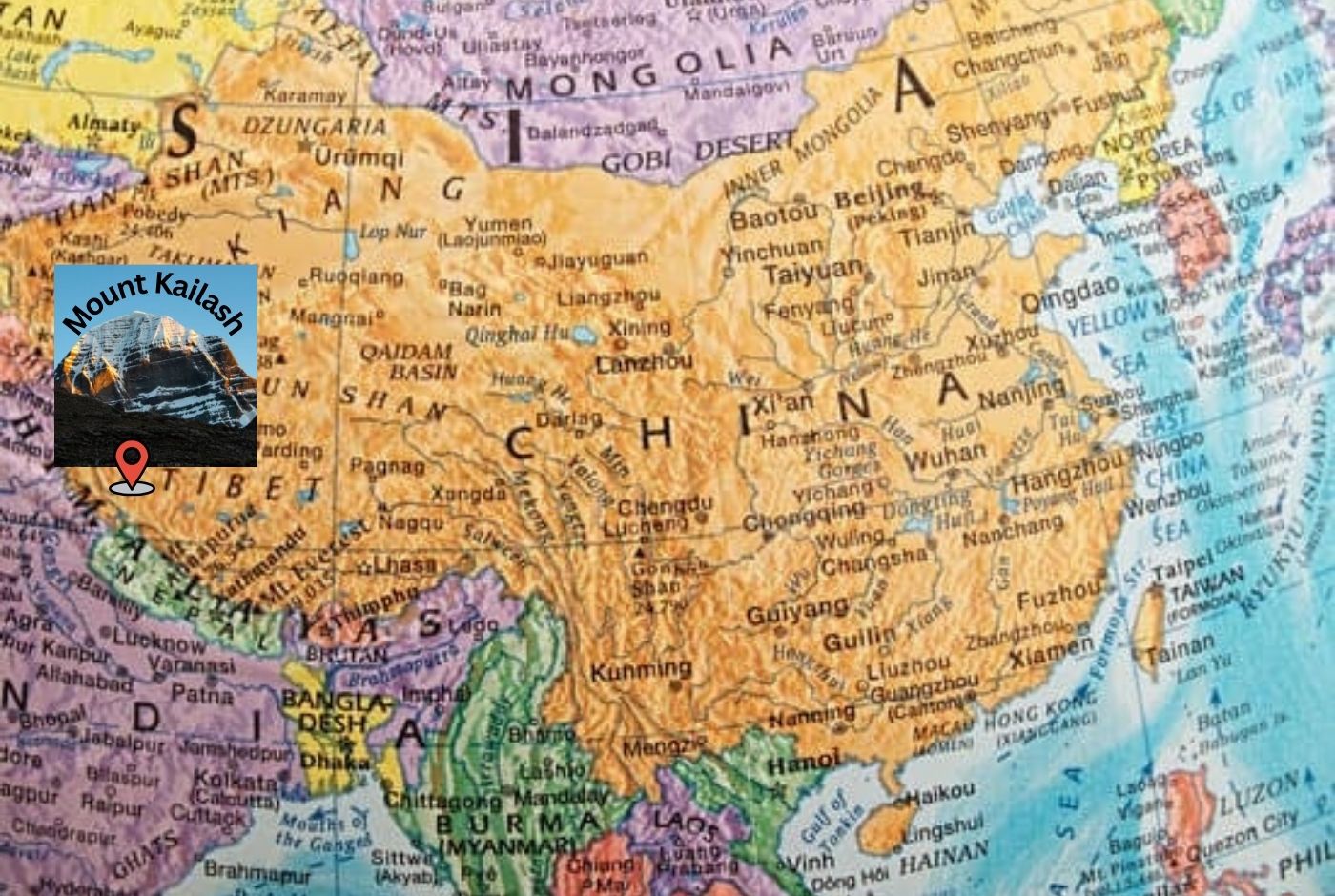
Where You'll Find Mount Kailash (kangrinboqe):
- Mountain Kailash is located in China's Tibet region, in Burang County within Ngari Prefecture.
- The exact spot is 31°4′0″N 81°18′45″E, and many people call this the center of the world.
- Kailash is in the Kailash Range, part of the vast Transhimalaya system that stretches across Tibet's high plateau.
- Four huge rivers start near here: the Indus, Sutlej, Brahmaputra, and Karnali.
- These rivers travel thousands of miles and provide water for millions of people across Asia.
What the Mountain Kailash Parbat Looks Like:
- Mount Kailash's height is 6,638 meters, which is over 21,000 feet high.
- The mountain has a pyramid shape that's pretty rare among peaks.
- Each side of the mountain faces north, south, east, and west almost perfectly.
- The face of Mount Kailash shows strange rock patterns that look almost carved.
- Snow sticks to the steep walls all year, making bright white lines against dark rock.
The Sacred Lakes, Nearby Mountain Kailash (Kangrinboqe)
- Mansarovar Lake sits just south of Mt Kailash and is one of the world's highest freshwater lakes.
- Lake Mansarovar covers 320 square kilometers and sits 4,590 meters above sea level.
- Hindu scriptures say these waters can wash away your sins and bring spiritual freedom.
- The lake acts like a giant mirror, reflecting the mountain perfectly on calm days.
- Lake Rakshastal is close by too, but its water is salty and darker; locals see this as representing good and evil.
Why Different Religions Love kangrinboqe Peak:
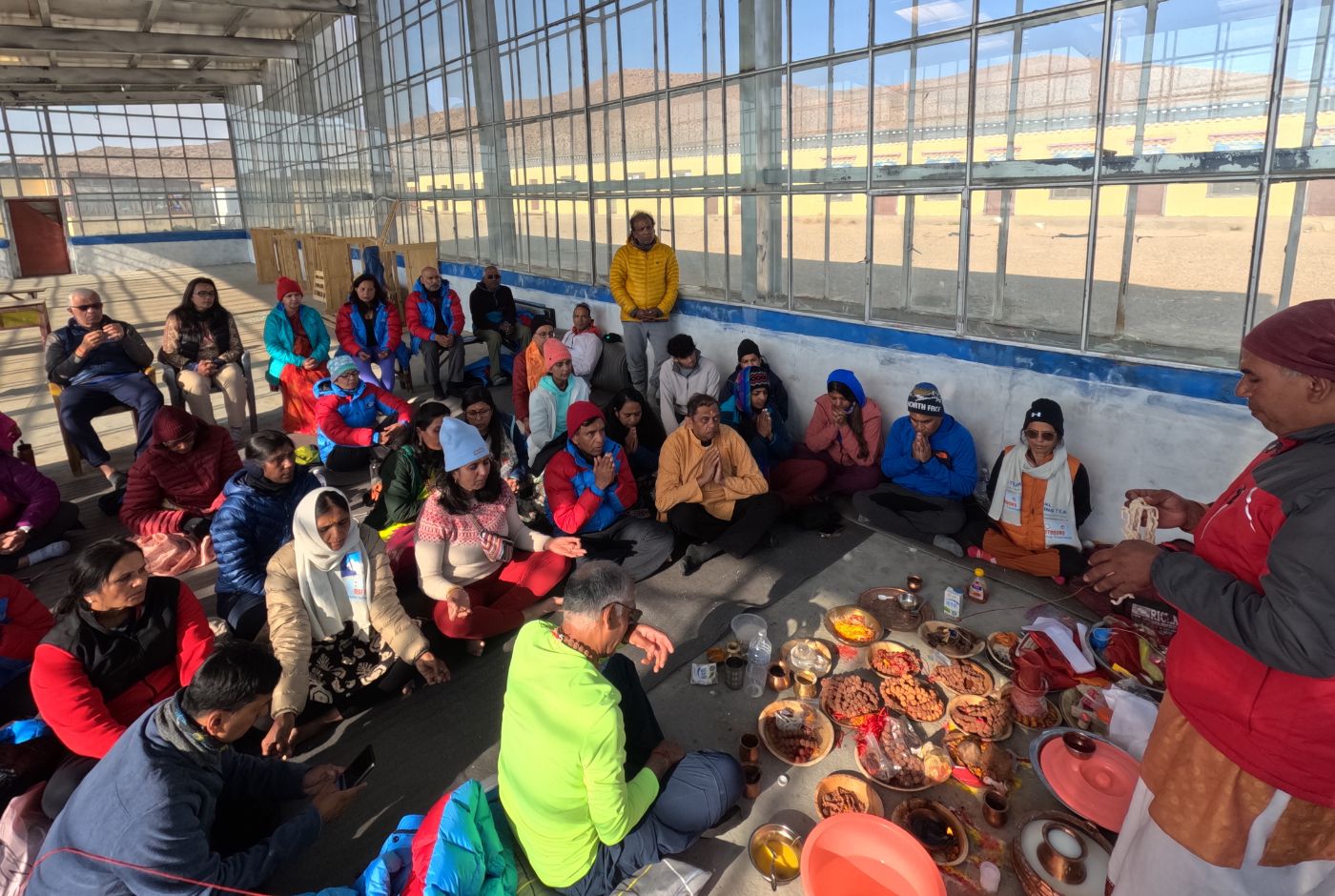
- Hindus believe Kailash is where Lord Shiva lives which makes the mountain sacred to millions of devotees.
- Ancient Hindu texts describe Shiva sitting on the peak in deep meditation. From there, he keeps the entire universe in perfect balance.
- The idea of the home of Lord Shiva brings millions of Hindu pilgrims here despite the tough journey.
- Buddhists traditionally see Kailash as where the deity embodying bliss, Demchok, lives; he represents pure happiness.
- Tibetan Buddhists walk around the mountain believing one trip erases a lifetime of bad deeds.
- The religion of Tibet mixes these Buddhist ideas with older Bon beliefs about the mountain's power.
- Jain people think Rishabhadeva attained enlightenment on these slopes, making it their holiest spot.
The spiritual significance of Mount Kailash (kangrinboqe) goes way beyond what any one religion teaches. People travel here from India, Nepal, Tibet, and other countries because they feel something special about this place. Lots of visitors talk about having deep spiritual moments during their trip.
This peak proves that some places matter to people across all kinds of boundaries. Whether you're Hindu and see it as Shiva's home, Buddhist and view it as a place of enlightenment, or Jain and consider it where liberation happened, Kailash Parbat connects the physical world with something beyond it.
Is Mount Kailash in China, India, or Nepal? In which country is Kangrinboqe peak?
When people talk about the sacred Mount Kailash, also called Kailash Parbat or Mountain Kailash, this question comes up a lot: Where is this mountain really located? Here's the straight answer: Mt Kailash sits completely inside the autonomous region of China.
Where is Mount Kailash Located? Mt Kailash on the world map!!!
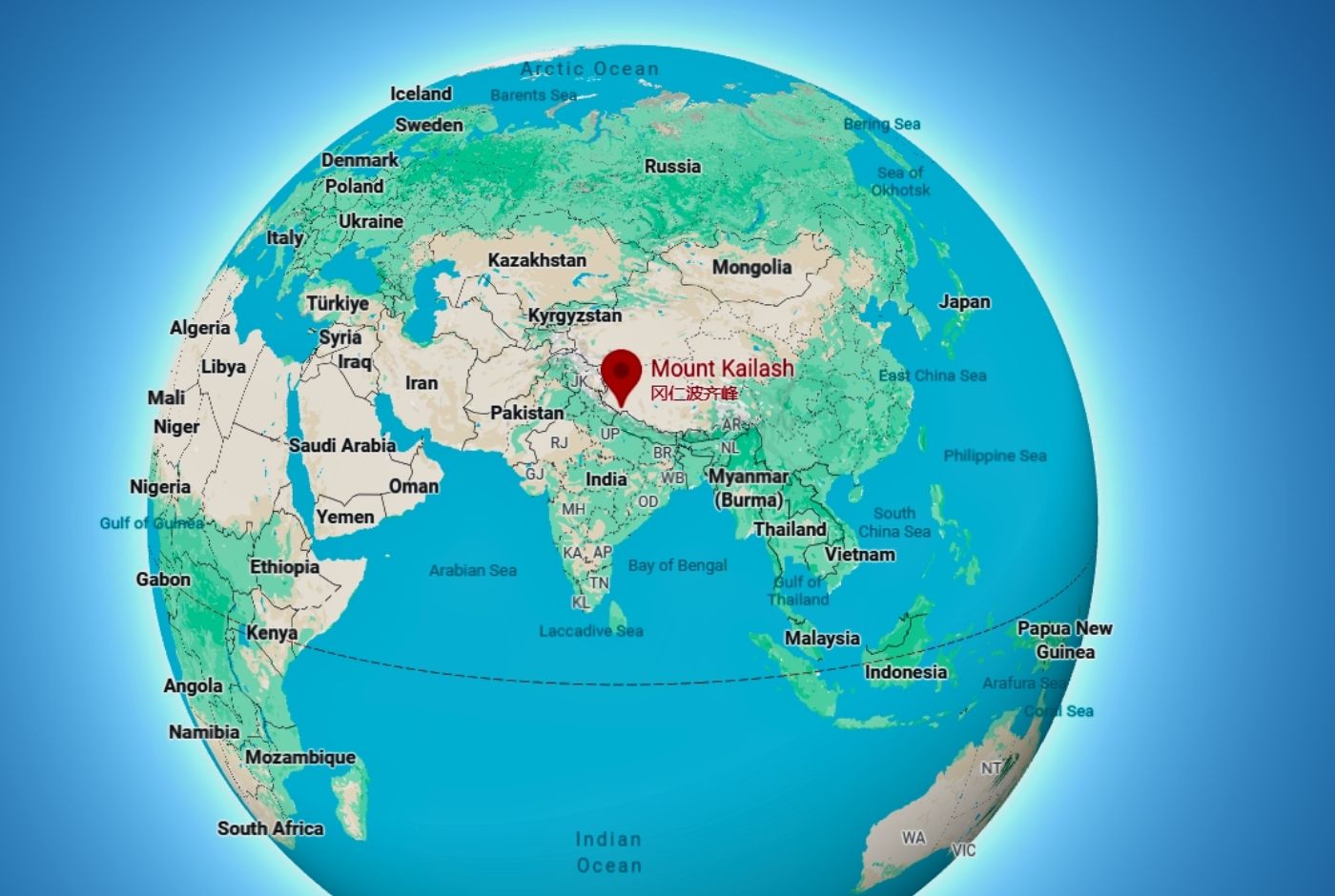
Why Some Think It's in India?
People get mixed up because the mountain sits very close to India's Uttarakhand state. For hundreds of years, people doing the Kailash Mansarovar Yatra have walked from India through the Himalayas to reach Tibet and visit this holy mountain.
Hindus believe it's the home of Lord Shiva, according to Hindu scriptures. This strong religious connection makes some people think the Mount Kailash Location must be inside India's borders.
Why Others Think It's in Nepal? Is Kailash in Nepal?
Mt Kailash also sits near Nepal's far western edge. Today, many pilgrims and travelers go through Nepal first before entering Tibet, especially when they're heading to Lake Mansarovar.
This freshwater lake is respected by all Hindus, Buddhists, Jains, and Bon. As so many people travel this way, some assume Kailash Parbat might be in Nepal.
The True Location and Significance of Mt. Kailash
Looking at maps, Mount Kailash reaches up to a massive height of 6,638 meters (21,778 feet) in the Kailash Range of the Transhimalaya mountains. People call it the center of the world, the point where everything connects.
Buddhists traditionally see it as a sacred place tied to reaching enlightenment. Jains believe this is where Rishabhadeva attained freedom from earthly life. Hindus know it as the home of Lord Shiva, and they say the face of Mount Kailash shows divine perfection.
Some call it Mount Meru, the sacred mountain from old stories, while others see it as part of the religion of Tibet. No matter how you look at it, its spiritual significance is huge.
From the calm waters of Mansarovar Lake to the snowy peak of Kailash Parbat, this special place keeps drawing people who want to experience something beyond ordinary life.
The Geography of Kailash Parbat: A Sacred Geological Wonder
Kailash Parbat sits in one of the most remote places on Earth. This mountain rises from the western edge of the Tibetan Plateau in the Kailash Range, looking like nature carved it with perfect precision. People from different religions call it the center of the world or the cosmic axis.
What makes this spot really special is how it works like Asia's water tower, as four huge rivers start their journey from right here. When pilgrims come for the Kailash Mansarovar Yatra, they're not just visiting a mountain. They're stepping into a place where geography and faith come together in ways that blow your mind.
Mount Kailash Height and Elevation above Sea Level | Kangrinboqe peak height
Mount Kailash has an elevation of 6,638 meters (21,778 feet) above sea level. It's located in the Tibetan Autonomous Region of China, near the borders of Nepal and India. Despite its relatively modest height compared to other Himalayan peaks, it's renowned for its distinctive near-perfect pyramid shape and its spiritual significance in several religions.
What is the height of Kailash Parvat?
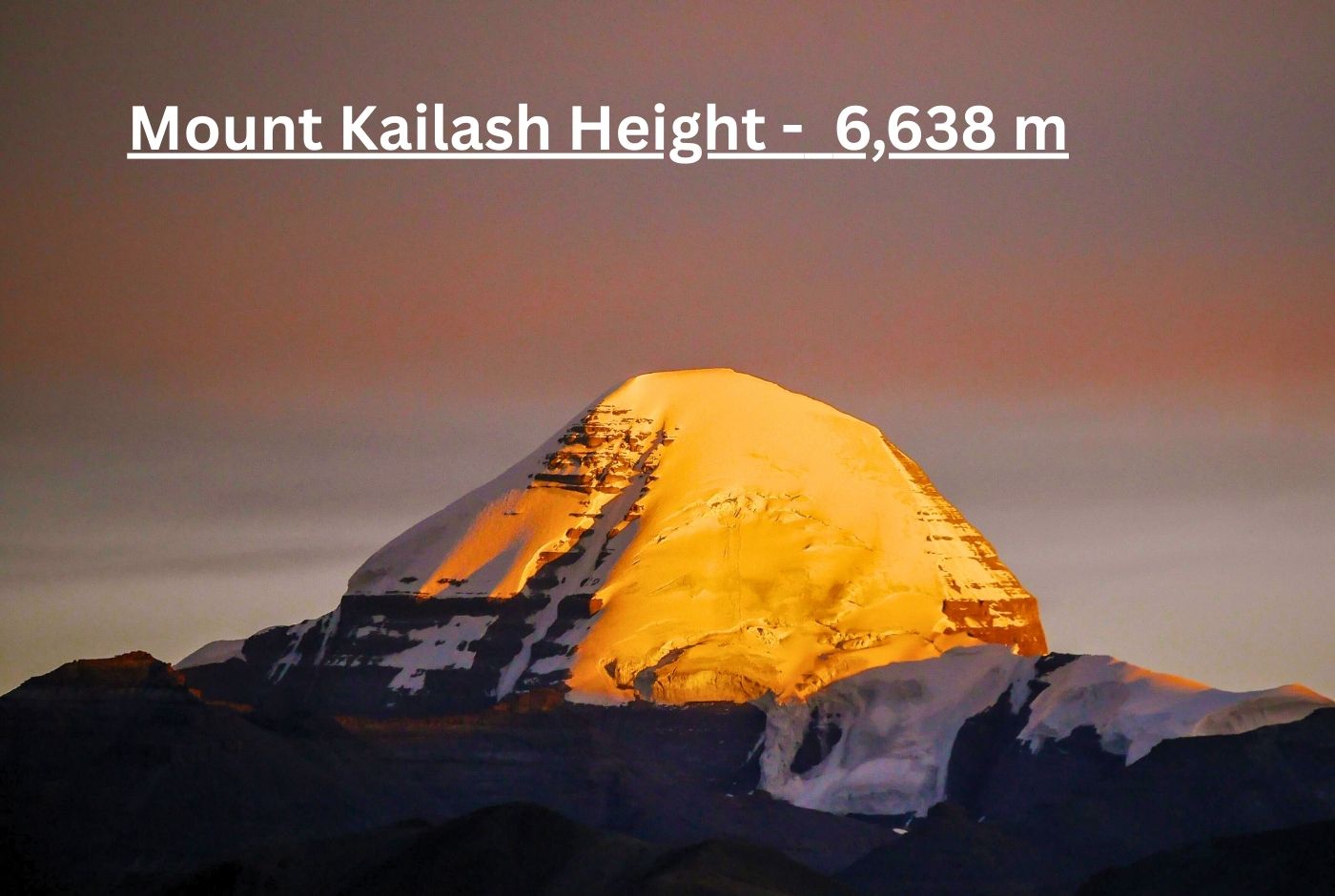
How Tall Is Mount Kailash? Is It Taller Than Mount Everest?
Mt Kailash reaches up to 6,638 meters (21,778 feet), which sounds pretty tall until you compare it to other famous peaks. Mount Kailash's height is actually way shorter than Mount Everest, which towers at 8,848.86 meters (29,032 feet). That's over 2,200 meters higher than Kailash Parbat.
Significance Beyond Stature: A Different Kind of Summit
What makes Mount Kailash famous isn't how many meters it reaches above sea level. It's about how deeply it touches people's hearts and souls.
Mount Everest draws climbers who want to prove they can conquer the world's tallest peak. Kailash Parbat works completely differently, as nobody climbs it because every religion here agrees it's too sacred to step on.
Instead, people walk around it. Pilgrims come from everywhere to do the Kailash Mansarovar Yatra, which means walking 52 kilometers.
It can take 12 hours or more, based on the time you take to pray or rest. For these travelers, the goal isn't reaching some summit. They want spiritual growth, inner peace, and a connection to something bigger than themselves.
Mansarovar Lake and the mountain together create a pilgrimage that changes people from the inside out.
Geology and Unique Formation
Mt Kailash looks nothing like the jagged, sharp peaks you see elsewhere in the Himalayas. This mountain is made mostly of black conglomerate and sandstone. It’s basically old sea floor that got pushed up when the Earth's plates crashed into each other millions of years ago. That's why it has this dark, dome-like shape that's so different from its neighbors.
The coolest part about this mountain is its four sides. They're almost perfectly symmetrical and line up exactly with north, south, east, and west.
Some devotees look at it and think it must be man-made because it's so geometrically perfect. But scientists have checked it out thoroughly, and it's 100% natural.
Kangrinboqe peak: The Hydrological Heart of Asia
The Mount Kailash Location isn't just spiritually important; it's also known as Asia's main water source. You can see four massive river begin their journeys within just 60 kilometers of this mountain:
- The Indus River heads west into Pakistan and eventually reaches the Arabian Sea.
- The Sutlej River is a major tributary of the Indus that flows through India.
- The Yarlung Tsangpo (which becomes the Brahmaputra River) flows east across Tibet, then turns south into India and Bangladesh.
- The Karnali River flows south, not directly at Kailash, but within the broader watershed into Nepal and eventually joins up with the Ganges.
Two famous lakes sit right next to the mountain. Lake Mansarovar is a freshwater lake that everyone considers pure and holy.
Lake Rakshastal is different as it's salty and shaped like a half-moon. Local people see these two lakes as representing good and evil, light and dark, the kind of balance that shows up in spiritual teachings everywhere.
Topography: The Four Sacred Faces
The face of Mount Kailash is what really sets this mountain apart from everything else around it. Those four steep, symmetrical sides naturally line up with the cardinal directions. That’s why so many devotees call it the cosmic axis and center of the world.
The South Face is probably the most dramatic. It has this striking vertical crack running down the middle, with horizontal rock layers crossing it. People call it the "Stairway to Heaven" because from far away, it looks like giant steps leading up to the sky.
When you see this view, it's easy to understand why believers think this holy mountain really is the abode of Lord Shiva and a bridge between our everyday world and whatever lies beyond it.
South Face of Mount Kailash Mountain
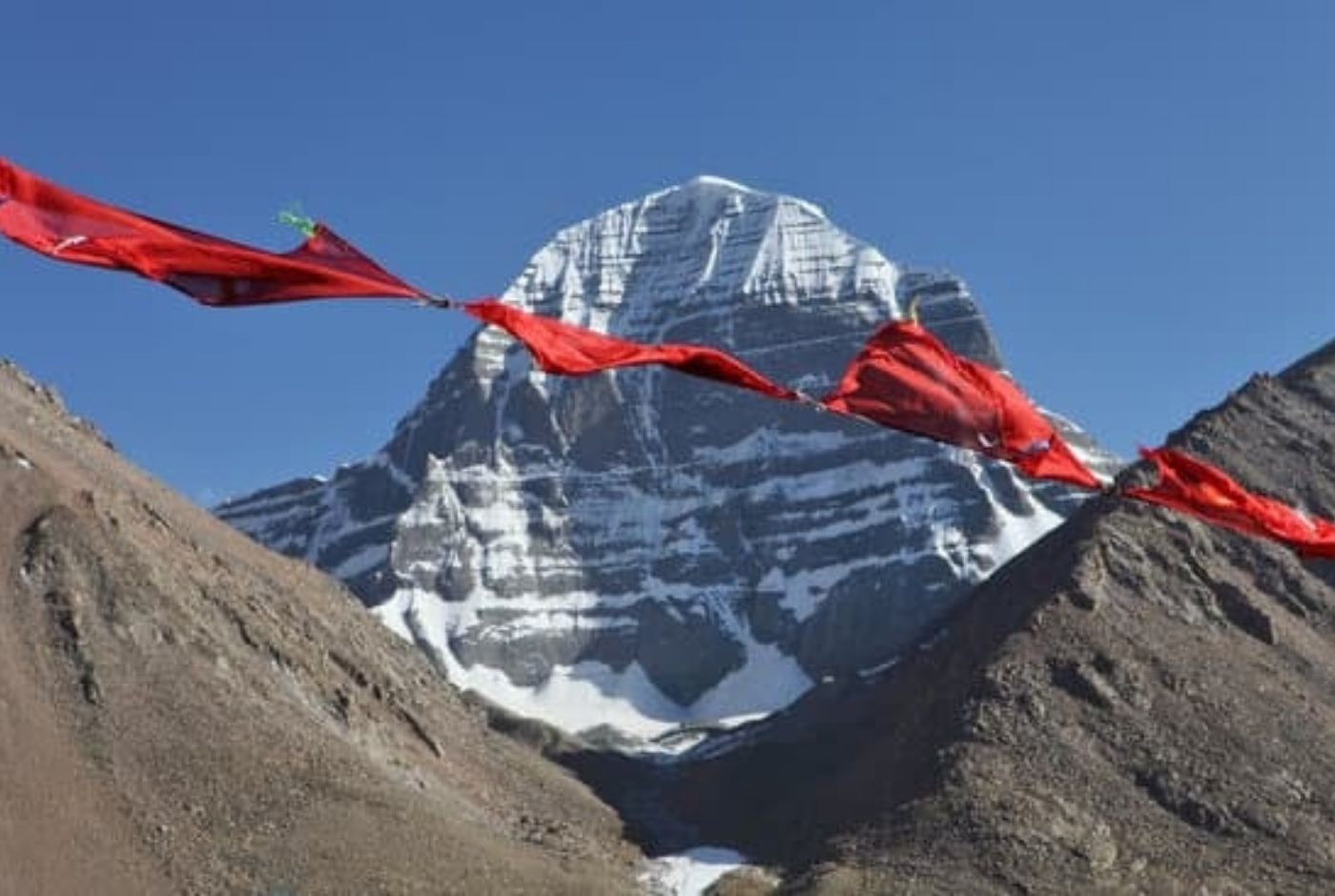
Mount Kailash (Kangrinboqe): The Sacred Mountain No One Has Ever Climbed
Way out in western Tibet, there's this incredible mountain that reaches up 6,638 meters (21,778 feet) into the sky. People know it by different names, such as Kailash Parbat, Kailash Parvat, Mountain Kailash, or even Kangrinboqe Peak.
The Mount Kailash Height makes it pretty impressive, and it sits right in the Kailash Himalaya as the star of the Kailash Range. But here's what makes this mountain different from Everest or K2. The mystery of Mt Kailash isn't about how hard it would be to climb. It's about what this place means to people.
Hindus see it as the abode of Lord Shiva, the home of Lord Shiva, and the center of the world. Buddhists call it Mount Meru - they think the whole universe spins around this cosmic axis.
Buddhists traditionally believe it's a place of perfect purity, while Jains are convinced that Rishabhadeva attained freedom from earthly life right here. In the religion of Tibet, this ranks as one of the holiest spots anywhere on Earth.
That's exactly why climbing Kailash Parbat is completely off-limits. It's not just illegal, it goes against centuries of deep respect and faith.
The Journey Around the Mountain
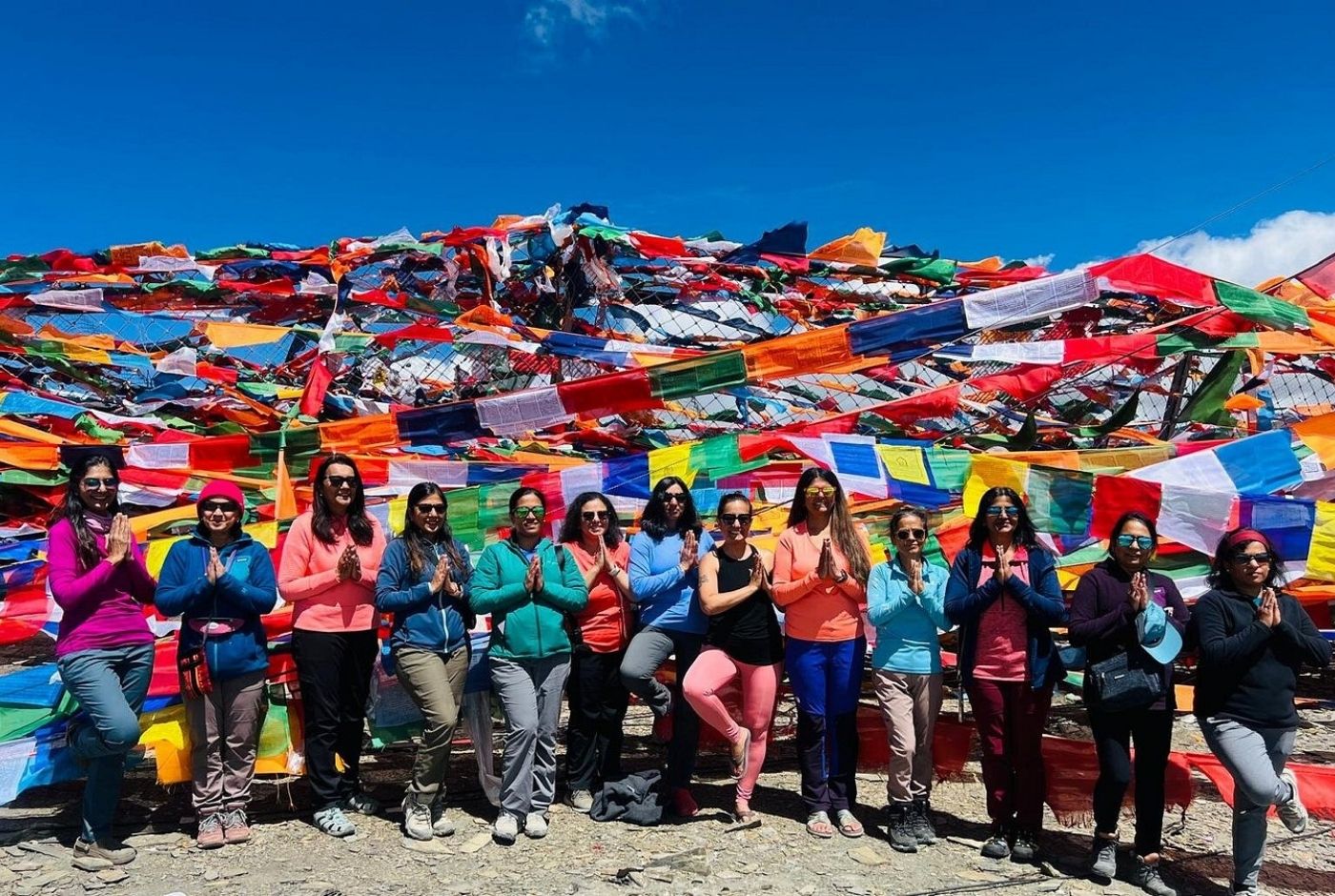
Every year, thousands of people make the tough trip to the Kailash Mansarovar Yatra. They travel incredibly long distances just to get close to this holy mountain.
The whole point isn't climbing to the top. Instead, people walk the sacred 52-kilometer Kora, which means going all the way around the face of Mount Kailash. Many try to finish this walk in 12 hours from Darchen because they believe it washes away a lifetime's worth of mistakes and bad choices.
Right at the mountain's base sits Lake Mansarovar, a fantastic freshwater lake that Hindu scriptures talk about with total admiration. Pilgrims also call it Mansarovar Lake, and it sits next to the peaceful Rakshastal. The lake is the heart of Kailash Mansarovar, and its clear waters look like they're reflecting something divine.
Why Climbing Kailash Is Prohibited?
- Religious Sanctity: In Hinduism, actually stepping on the slopes of Mount Kailash would be like sinning. Buddhism, Jainism, and Bön traditions feel exactly the same way. Pilgrims want to grow spiritually, not conquer some physical challenge.
- Official Protection: The Chinese government has put a strict ban on climbing Kailash. They don't issue expedition permits to anyone, which keeps the mountain's sacred status protected for devotees.
- Natural Barriers: This mountain has steep faces, crumbly rock, sudden snowstorms, and it's in the middle of nowhere. Trying to rescue climbers on Mount Kailash is considered almost impossible.
Legends and the Untouchable Summit
Milarepa was a holy man from Tibet in the 1100s. Stories say he got into a contest with another monk. They both tried to reach the top of Kailash first. Milarepa won by getting there right at sunrise. But when he came back down, he said something surprising. He told everyone the mountain should never be climbed again. People still follow his rule today.
Modern stories add even more mystery. Climbers have turned back because of sudden sickness, fear, or getting completely disoriented.
There's this unverified story from the 1990s about a Siberian team that supposedly crossed some forbidden line, aged really fast, and died soon after. Nobody can prove these stories are true, but they make people even more convinced that this sacred mountain was never meant to be conquered.
Kailash and the Skies Above
Commercial planes don't fly over Mt Kailash. Some people claim there are magnetic problems that mess with navigation, but the real reasons are more practical.
The high altitude affects how planes perform, and since the area sits close to sensitive borders, the airspace has tons of restrictions.
How high is Mount Kailash Parbat?
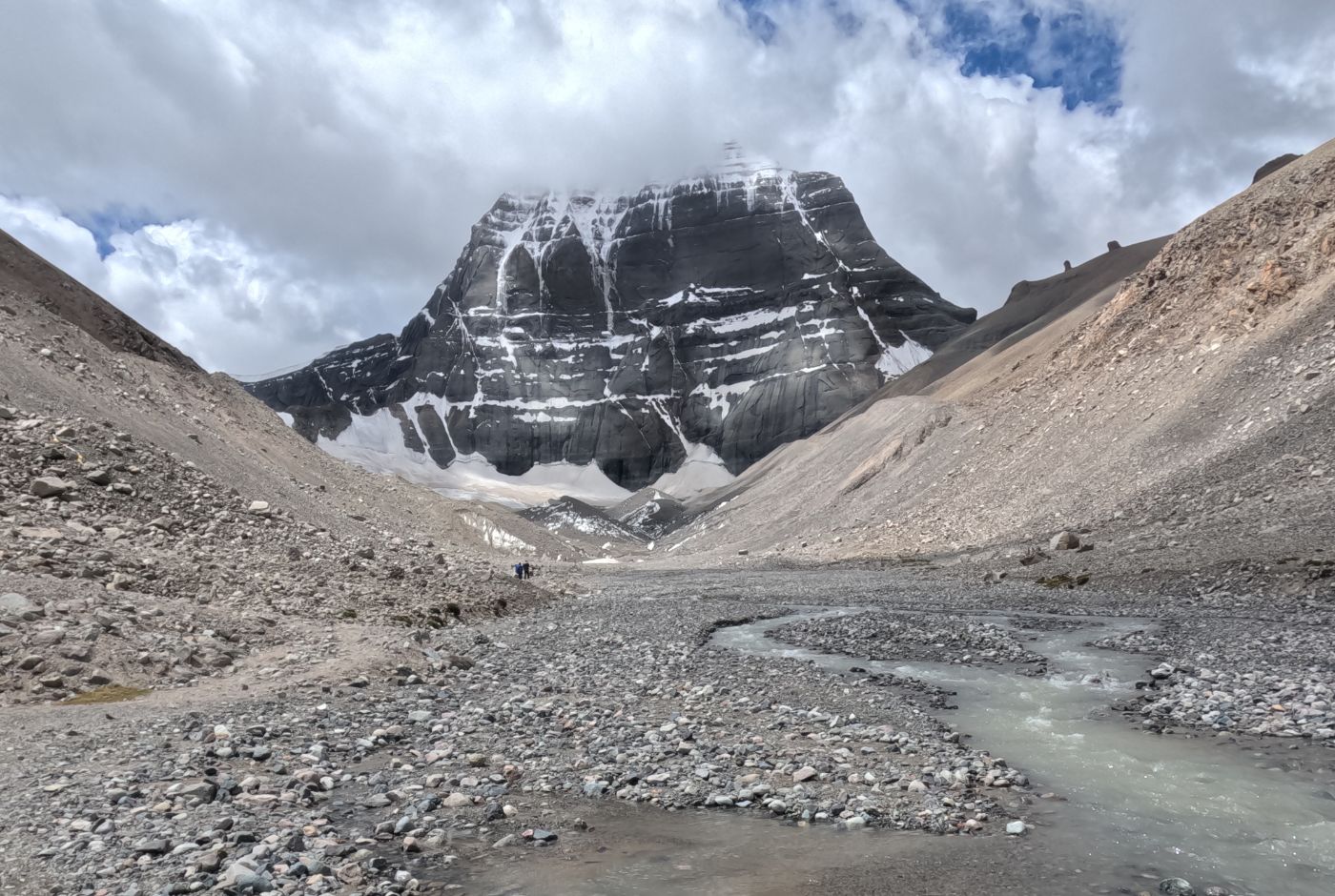
NASA, Myths, and Mysteries
You'll find online theories claiming Kailash is actually a man-made pyramid or lines up perfectly with other ancient structures. But NASA has never made any official statement backing up these discoveries.
The mystery is part of what makes this place so fascinating, mixing Hindu scriptures, Tibetan tradition, and wild speculation that nobody can prove.
In Myth and Scripture
In the Mahabharata, the Pandavas' final journey took them north toward the Himalayas, representing their climb to heaven.
People often connect this to Kailash Mandir, Adi Kailash, or even the India Kailash Temple legends. However, this was really a spiritual story, not some record of actually climbing Kailash Parvat.
The Pilgrimage Beyond Borders
From Kinnaur Kailash in Himachal Pradesh to Madhya Kailash Temple in Chennai, from Madhya Kailash traditions to the amazing Kinner Kailash, the name "Kailash" means something special all across India.
Even that incredible architectural masterpiece, the Kailash Temple at Ellora. Devotees also call it Kailash Mandir Maharashtra, which was built to honor the greatness of Kailash Parbat which is not a literal dedication to the physical Mount Kailash in Tibet..
Not everything with "Kailash" in the name is a mountain. People carry this name too, from Nobel Prize winner Kailash Satyarthi to leaders like Kailash Gahlot.
A Mountain Chosen to Remain Untouched
The story of Mt Kailash is unique. While you can scale, map, and conquer the world's tallest peaks, Kailash Parbat stands apart from the rest of the mountains. It's like a permanent reminder for you that some summits aren't meant for climbing with boots and ropes, they're meant for prayers and deep respect.
For people who walk the Kailash Mansarovar path, from the freshwater lake of Mansarovar to the face of Mount Kailash, the journey isn't about reaching the top. It's about touching something much deeper inside yourself.
Mountaineers and the Mystery of Kailash Parvat (kangrinboqe peak)
The story of climbing Kailash goes way beyond just physical strength and endurance. This is where modern mountain climbing dreams crash head-on into centuries of sacred tradition.
Sitting in the remote Kailash Range, Mt Kailash looks down on Lake Mansarovar. When pilgrims do the Kailash Mansarovar Yatra, they travel thousands of kilometers.
Mythical Ascents and Timeless Legends
- The Ascent of Milarepa: Tibetan tradition tells us that only one person ever made it to the summit, an 11th-century holy man named Milarepa. He didn't use ropes and ice axes like modern climbers. The story says he went up through spiritual power, making it an act of enlightenment rather than physical conquest.
- The Journey of the Pandavas: The Mahabharata talks about the Pandavas taking their final journey into the Himalayas to reach heaven. The story brings them to this sacred area, but it's more symbolic and spiritual than the actual history of anyone climbing Kailash Parvat.
- Jain Beliefs: Jain tradition says Rishabhadeva attained liberation right here, which adds even more spiritual significance to this mountain.
History of Mount Kailash Parbat
Mount Kailash, a revered peak in Tibet, remains unclimbed due to religious significance rather than insurmountable physical challenges. While legends suggest a Tibetan monk named Milarepa may have reached the summit in the past, no modern climber has officially ascended it. Today, climbing is officially banned, and the focus remains on the spiritual journey of circumambulating the mountain (kora).
Historic Encounters with the Sacred Mountain
- 1926 – Wilson's Assessment: Colonel R. C. Wilson surveyed the mountain during his reconnaissance mission. He identified the southeast ridge as a potential climbing route. Heavy snowfall forced his team to retreat before attempting a serious ascent.
- 1930s – Ruttledge's Verdict: British mountaineer Hugh Ruttledge examined the formidable north face. His blunt assessment was damning: "utterly unclimbable." His judgment shaped Western climbing opinions for decades.
- 1936 – A Garpon's Wisdom: Austrian mountaineer Herbert Tichy asked a Tibetan leader called a Garpon if climbing Mount Kailash was even possible. The guy's answer became famous: "Only a man entirely free of sin could climb Kailash. And he wouldn't scale the ice, he would turn into a bird and fly to the summit."
- 1980s – Messner's Refusal: When legendary climber Reinhold Messner got rare Chinese permission to try Kailash Parvat, he turned it down. His reason was pretty powerful: "If we conquer this mountain, then we’ll conquer something in people's souls. Better to climb something harder."
- 2001 – The Ban Becomes Law: A Spanish team asked for access but got rejected. Chinese authorities made it official that climbing on Mt Kailash is completely banned. Moreover, climbing was already prohibited informally before that year.
- For mountaineers, Kailash Parvat creates this incredible puzzle: it's a peak that calls to them like crazy, but no rope will ever touch it. For pilgrims, this isn't a mountain to beat. It's the home of Lord Shiva, the eternal holy mountain, and proof that some summits are meant only for the spirit to reach.
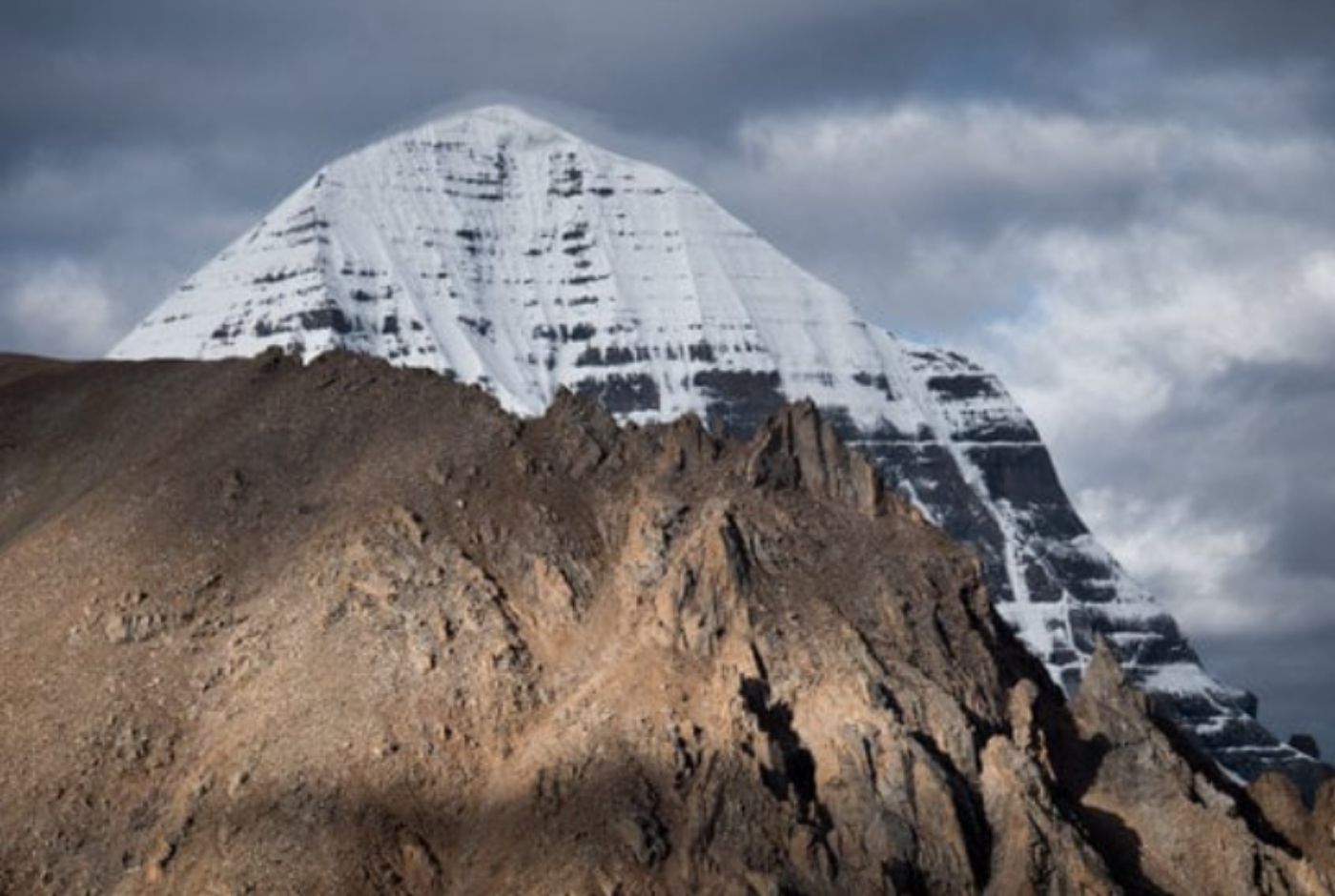
10 Fascinating Facts About Mount Kailash
Mount Kailash, often called Kailash Parbat or Kailash Parvat, shoots up 6,638 metres (21,778 feet) in the remote Kailash Himalaya of western Tibet. This isn't just any mountain, it's your spiritual lighthouse, a natural wonder, and a place where your ambition takes a back seat to divine respect. For thousands of years, pilgrims have walked its sacred paths, while mountaineers have stepped back in wonder, knowing that climbing Kailash is something both faith and law say no to.
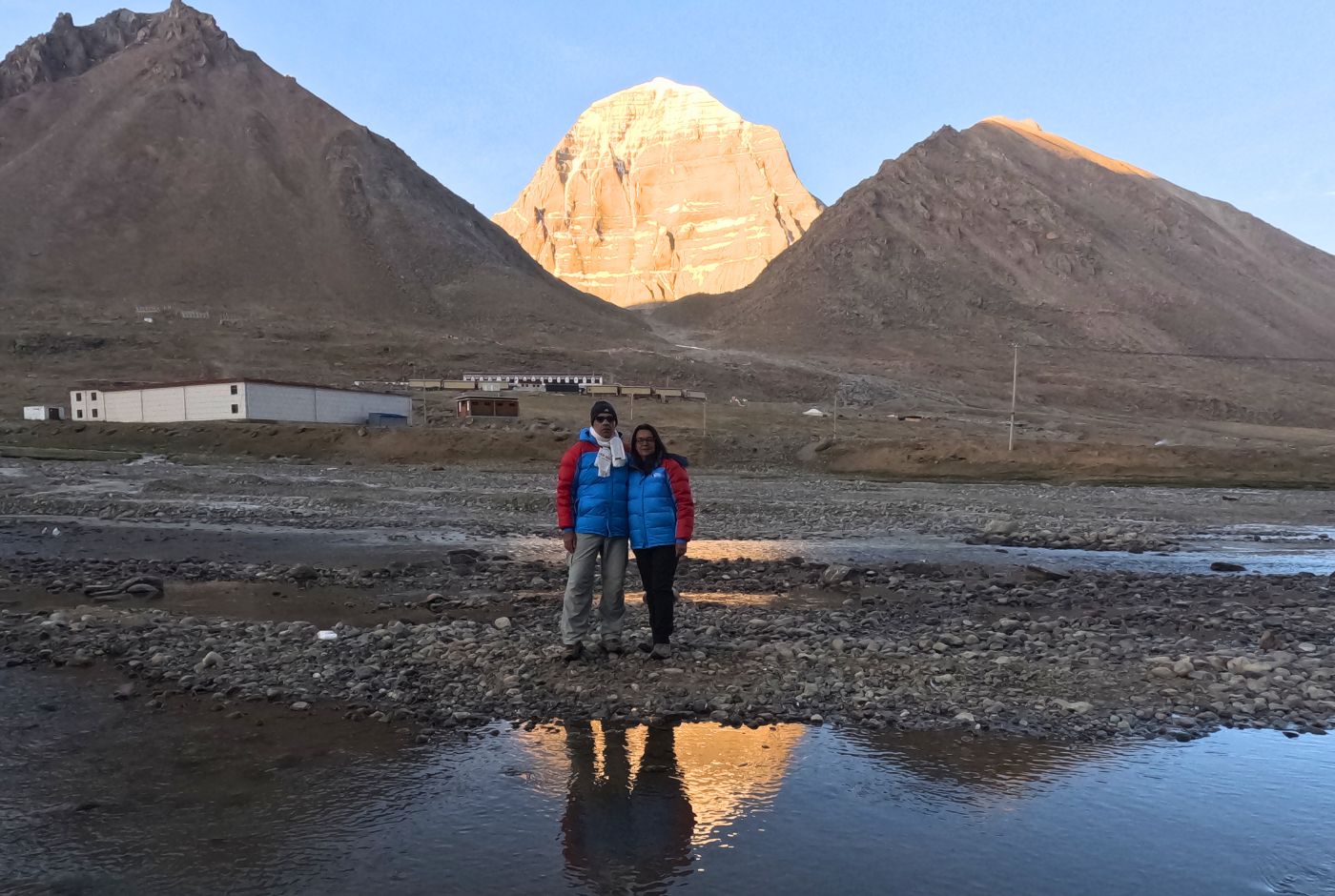
The Unclimbed Summit
Even though it's way shorter than Everest, Mt Kailash has never been climbed by anyone. The Chinese government has banned all attempts for years, respecting what millions of believers hold dear. In fact, climbing has been prohibited for decades, with a formal reinforcement of the ban around 2001.
While other peaks tempt climbers with dreams of conquest, Kailash draws pilgrims with promises of spiritual growth.
A Crossroads of Four Faiths
Mountain Kailash is pretty special because four major religions all see it as sacred:
- Hindus call it the abode of Lord Shiva, where he sits in eternal meditation.
- Buddhists think it's the earthly version of Mount Meru, the center of everything.
- Jains believe Rishabhadeva attained freedom from earthly life here.
- Bön followers see it as the spot where their founder came down from heaven.
A Marvel of Natural Symmetry
The amazing shape of Kailash Parbat has got people thinking for ages. Its pyramid-like peak lines up perfectly with north, south, east, and west, making it stand out from the rough Kailash range around it.
Some people even point out weird distances between Kailash and other ancient places, which just adds to its mysterious vibe.
The Birthplace of Great Rivers
The slopes of Mt Kailash hold the starting points of four huge rivers: the Indus, Sutlej, Brahmaputra, and Karnali.
These waters feed vast areas, from the Indian plains to the Tibetan plateau. This makes the region not just sacred but also a water source that keeps millions of people alive.
The Jewel-Faced Mountain
Old texts talk about the four faces of Kangrinboqe Peak (Kailash) being made of crystal, ruby, lapis lazuli, and gold. The face of Mount Kailash facing south shows this snow-filled crack that looks like the sacred OM symbol.
Twin Lakes of Light and Shadow
Right at the mountain's base sits Mansarovar, a perfectly round freshwater lake that people say formed from divine thoughts.
Next to it you can see crescent-shaped Rakshastal, a salty lake tied to darker stories. People often compare these two to yin and yang, showing how nature keeps things balanced.
Myths of Time Itself
Local stories tell about pilgrims whose hair and nails grew weeks' worth in just 12 hours near Kailash. Science hasn't backed this up yet, but the story sticks around as part of what makes this mountain so mysterious.
The Sacred Circuit
Instead of climbing up, pilgrims do the Kailash Mansarovar Kora, a 52-kilometer walk around the mountain.
Hindus and Buddhists go clockwise, while Bön followers walk the other way. Finishing even one lap is supposed to wash away lifetimes of bad karma.
The Only Summit in Legend
History only tells of one person ever reaching the top, Milarepa, an 11th-century Tibetan holy man. His climb wasn't about ropes and ice axes but spiritual power. The story says he flew to the summit, creating a legacy that keeps the mountain untouchable.
A Center of Earthly Energy
Lots of pilgrims think Kailash Parbat connects to other sacred places like Egypt's pyramids through some invisible energy network.
This belief might be beyond what science can prove, but it adds to the feeling that Kailash is the spiritual heartbeat of the world.
Gauri Kunda (Gauri Kund)
Gauri Kunda, also known as Gauri Kund, is a sacred lake near Mount Kailash, revered in Hinduism and Tibetan Buddhism. It's named after Goddess Parvati (also known as Gauri), the wife of Lord Shiva), and is believed to be the place where she performed penance to win Shiva's affection. The lake is situated at an altitude of 5,608 meters (18,399 feet) along the Kailash Parikrama (circumambulation route).
Gauri Kunda of Kailash Parbat
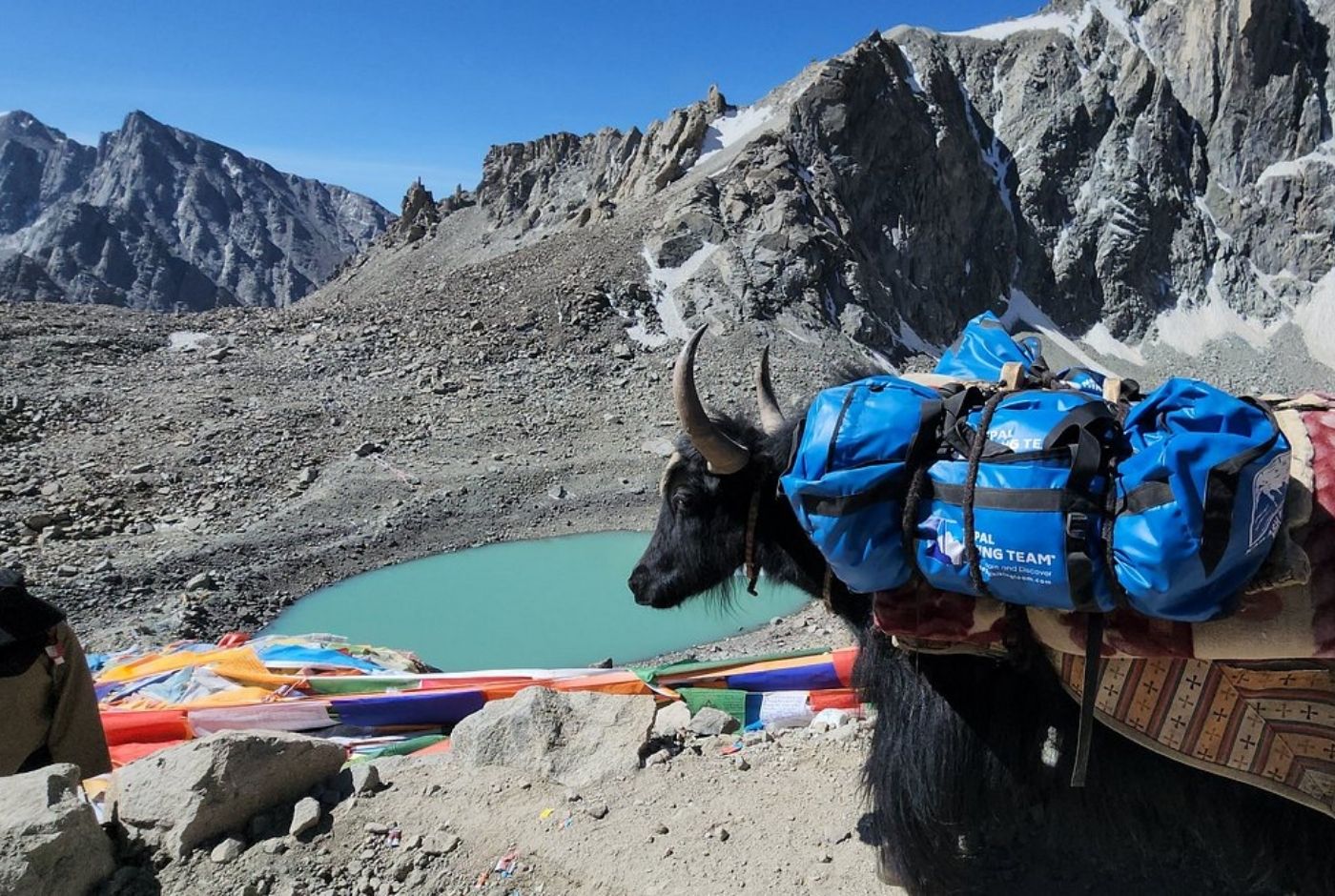
How to Reach Mount Kailash
Mount Kailash is in the remote corners of western Tibet, far from all major cities. Hindu scriptures call it the home of Lord Shiva. This sacred mountain in the Kailash range isn't just a stunning piece of geography; it's your spiritual heartbeat for millions of people across Asia.
Pilgrims know it as Kailash Parbat, and many see it as the center of the world and the cosmic axis where everything begins.
Getting there takes serious planning, permits, and plenty of patience. The journey is both practical and spiritual, testing your body and soul.
Depending on where you start, Nepal, India, or China, there are different routes to choose from. Each path has its own adventures, challenges, and rewards.
🇳🇵 Route 1: From Nepal
Nepal is the most popular starting point for both international travelers and Indian pilgrims. The country offers easy access plus those jaw-dropping Himalayan views. Kathmandu works as your gateway, and experienced tour operators there handle the Tibet Group Visa and all the paperwork headaches.
Option A: Overland Route
Route: Kathmandu → Rasuwa Border (Kyirong/Gyirong) → Saga → Darchen
Outline of the Mount Kailash Journey:
- Arrive in Kathmandu: You’ll have to spend 2-3 days getting your visas sorted and letting your body adjust to the altitude.
- Drive to Rasuwa Border: Then, you’ll cross into Tibet at the Kyirong/Gyirong crossing point.
- Continue overland: Travel through Saga and Paryang to reach Darchen, the base town for Mt Kailash.
- Begin the Kora: Finally, you'll get to start the 52-kilometer sacred walk around the mountain.
Duration: 12-15 days (round trip from Kathmandu)
Advantages:
- Your body adjusts to altitude gradually, which cuts down on your altitude sickness
- These tours are affordable and easy
- You’ll get to enjoy amazing views of the Kailash Himalaya and Tibetan plateau
Challenges:
- You’ll have to spend long days sitting in vehicles on bumpy roads
- Border delays happen because of weather or changing rules
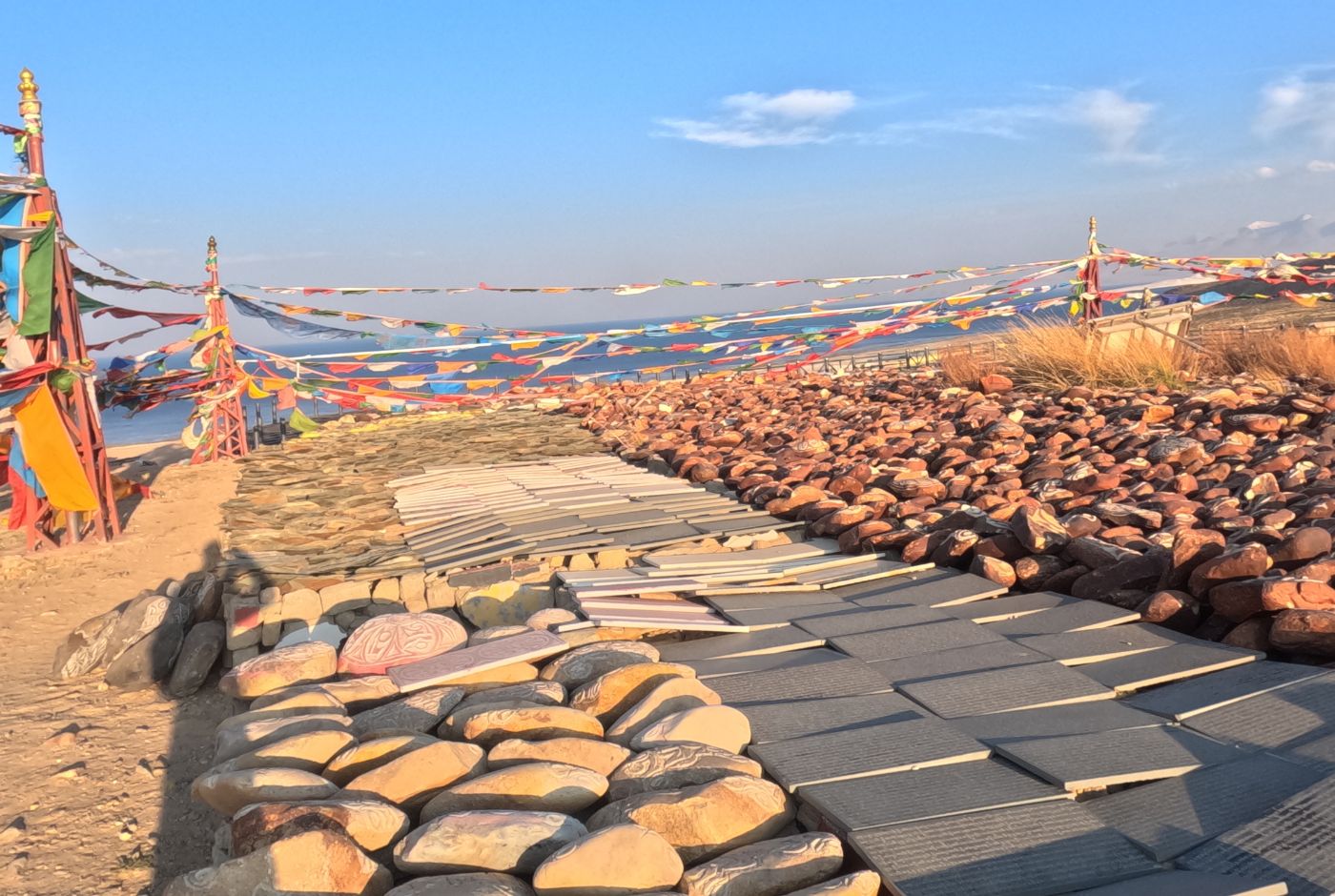
Option B: Helicopter Route
Route: Kathmandu → Nepalgunj → Simikot → Hilsa (by helicopter) → Taklakot → Darchen
Journey Outline of Your Helicopter Route:
- You’ll fly to Nepalgunj, then continue to Simikot (2,910 m) to get used to the height.
- Take a helicopter to Hilsa and cross the border into Tibet.
- Drive to Taklakot, then continue to Lake Mansarovar and Darchen.
Duration: 9-11 days (round trip from Kathmandu)
Advantages:
- Perfect if you're short on time
- Less physical stress before your actual trek begins
- Private operators run these trips really conveniently for you
Challenges:
- Costs more than driving overland
- Your flights can get canceled because of bad weather
- Helicopters have strict weight limits for luggage
🇮🇳 Route 2: From India
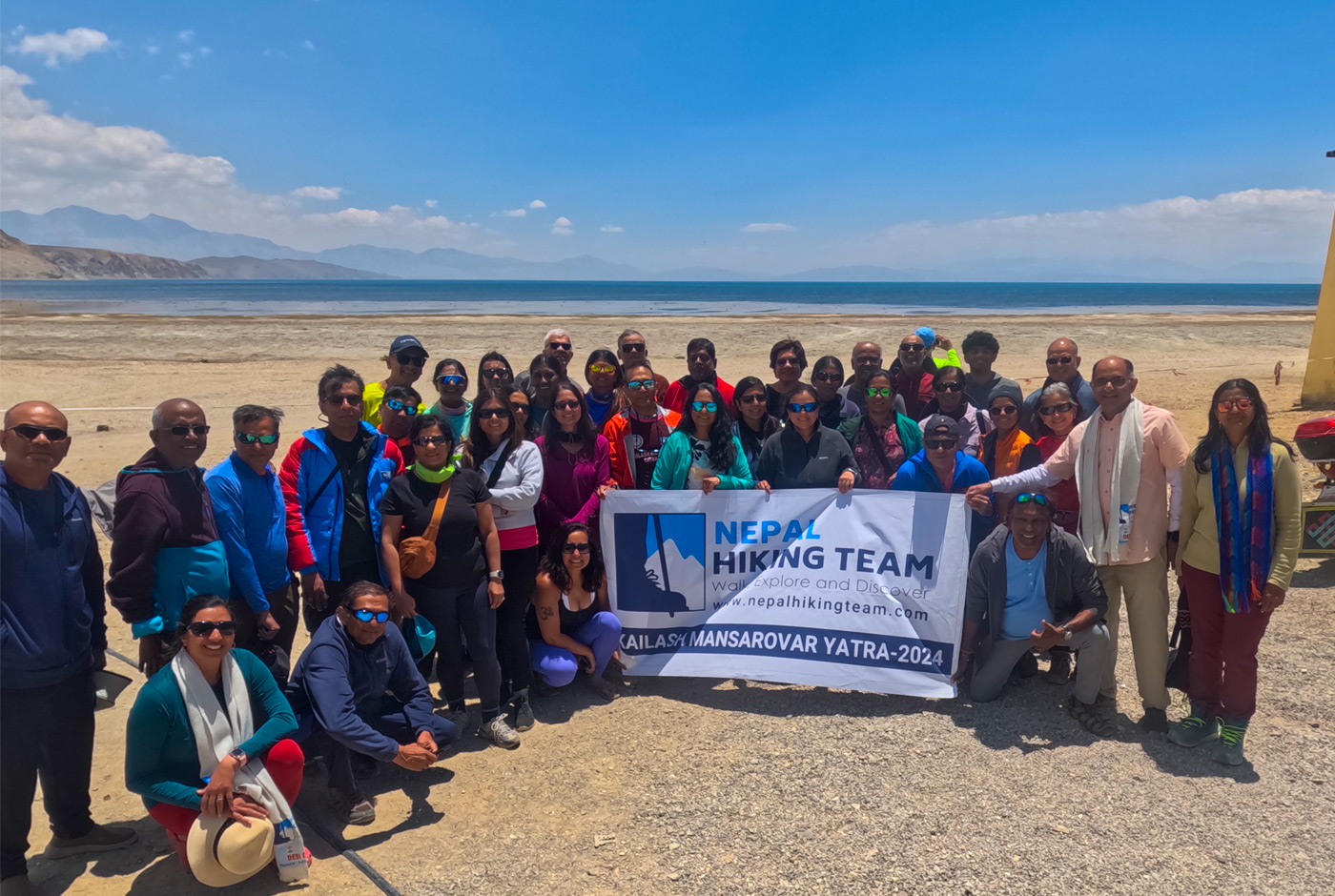
For Indian citizens, traveling to Mountain Kailash often feels like a personal spiritual journey. This route follows the same paths that saints, traders, and spiritual seekers have used for hundreds of years.
Option A: Official MEA Yatra
India's Ministry of External Affairs organizes this traditional pilgrimage route. It's especially meaningful for you if you see this as a journey of faith.
Route A (Lipulekh Pass): Delhi → Dharchula (Uttarakhand) → Lipulekh Pass → Taklakot → Darchen
Route B (Nathu La Pass): Delhi → Gangtok (Sikkim) → Nathu La → Shigatse/Saga → Darchen
Total Duration: 22-25 days
Advantages:
- Consists of rich history and deep religious meaning
- Government supports your medical help and security
- Provides you with a true Himalayan trekking experience
Challenges:
- The Lipulekh route allows you to trek at high altitudes
- Only limited spots are available for devotees through a lottery system
- Sometimes, weather problems can entirely mess up your schedule
Option B: Private Tour via Nepal
If you don't get picked in the lottery, private tour operators in Kathmandu offer another way to get there.
Advantages:
- No lottery needed as you get confirmed travel dates
- Flexible schedules and shorter trips (10-14 days)
Challenges:
- You pay for everything yourself
- Need proper visas and an Indian passport
🇨🇳 Route 3: From Mainland China
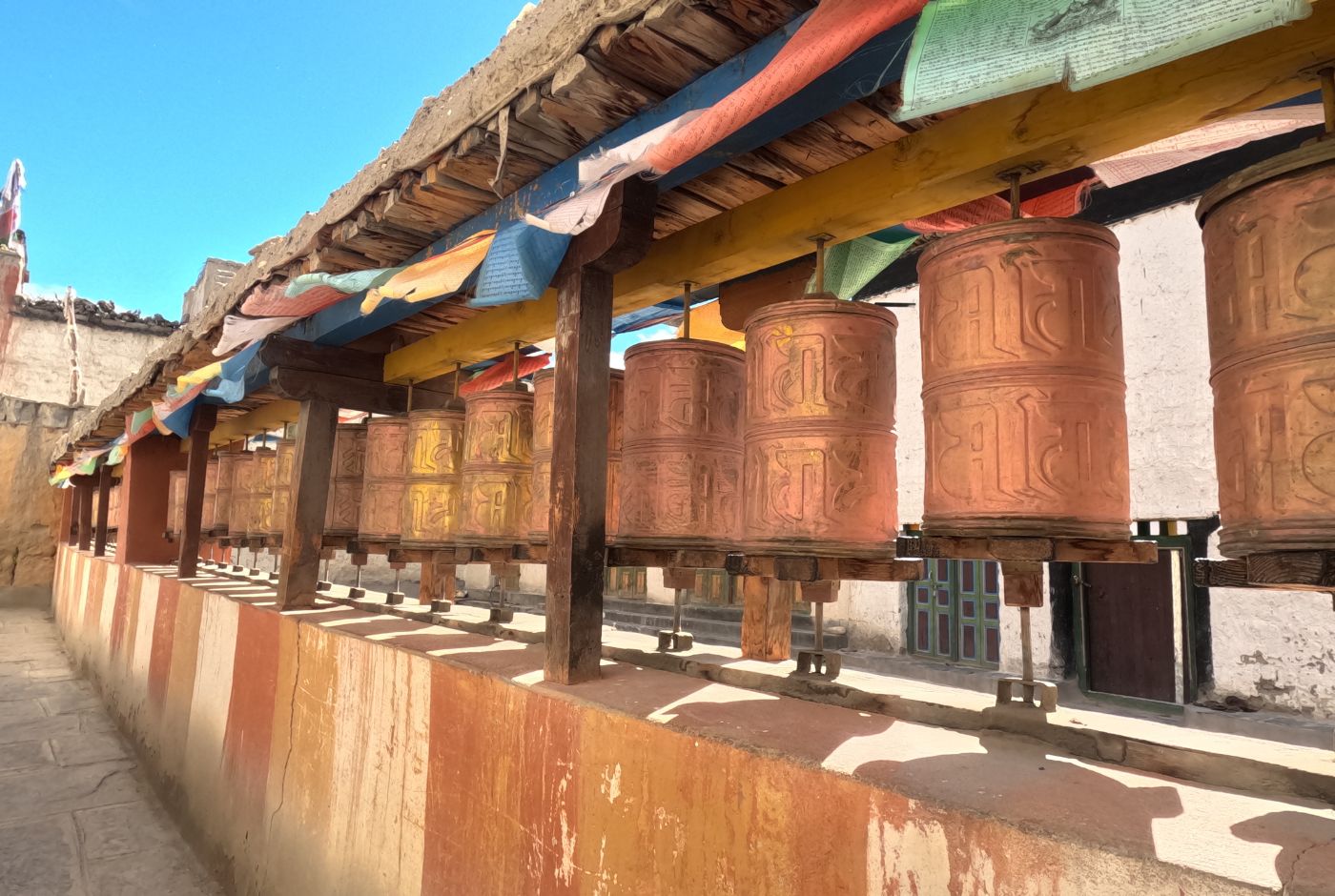
If you're already in China, you can reach Mt Kailash more directly. Many people combine this trip with other Tibetan cultural experiences.
Route: Lhasa → Shigatse → Saga → Darchen
Journey Outline:
- Get a Chinese Tourist Visa
- You’ll have to book with a licensed Tibetan tour operator
- Then, you’ll fly or take the scenic high-altitude train to Lhasa (3,650 m)
- You’ll get to spend 3 to 4 days exploring Lhasa's treasures like Potala Palace and Jokhang Temple
- Continue overland through Shigatse and Saga to Darchen
Duration: 15-17 days (round trip from Lhasa)
Advantages:
- Plenty of time to get used to the altitude in Lhasa
- Most direct route if you're already in China
- Offers deep cultural experiences
Challenges:
- Higher costs because you’ll get flights and pay for permit fees
- If you’re a foreign visitor, you must use guided tours in Tibet
Final Step, Kailash Kora
No matter which route you take, all journey to Kailash Parbat ends at the same place. This trek isn't about climbing Kailash but about walking around the sacred mountain with respect and devotion.
The walk takes three days. You'll cross high mountain passes, walk through glacial valleys, and see the shores of Mansarovar Lake, a freshwater lake that people say formed from divine thoughts.
For believers, every step is like a prayer. For travelers, it's a rare chance to walk in the shadow of a peak that many consider the center of the world. It's a journey where your physical challenge can match your spiritual experience depth.
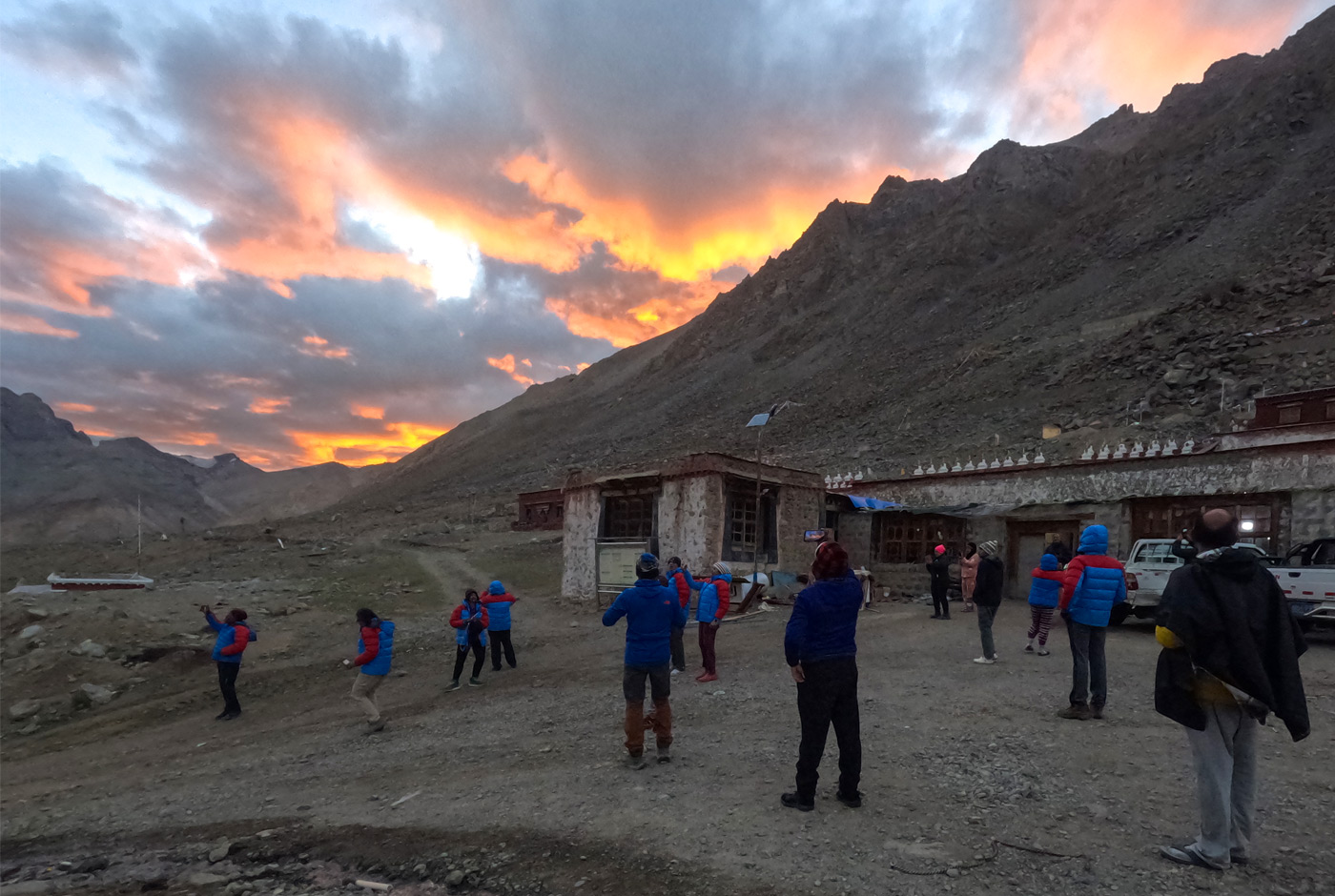
Most Asked Questions of Mount Kailash Mansarovar
1. Where exactly is Mount Kailash located?
Mount Kailash, called Kailash Parbat and in Tibetan as Kangrinboqê by locals, shoots up from western Tibet's high plateau. The peak sits inside China's Tibet Autonomous Region as part of the bigger Kailash Range. Four major religions see this mountain as the world's spiritual center. Pilgrims have walked brutal paths here for hundreds of years. The mountain sits near India and Nepal but belongs completely to China.
2. Where is Mansarovar Lake, and why is it important?
Mansarovar Lake is a beautiful freshwater lake situated close to Mount Kailash in Tibet. It's one of the world's highest freshwater lakes and holds deep religious meaning, especially for Hindus, Buddhists, Jains, and followers of Bon. Pilgrims doing the Kailash Mansarovar journey often visit this peaceful lake because people see it as a symbol of purity and spiritual cleansing.
3. What is Kinnaur Kailash, and how is it different from Mount Kailash?
Kinnaur Kailash, also called Kinner Kailash or Kailash Nath, is a holy peak in the Indian Himalayas, specifically in Himachal Pradesh's Kinnaur district. Even though it shares the Kailash name and has religious importance, it's totally different from the Tibetan Mount Kailash. Kinnaur Kailash has its own temple and pilgrimage traditions focused on Himalayan deities.
4. Can Mount Kailash be seen from India?
Mount Kailash sits pretty close to the India-China border, but the rough terrain and high altitude usually block views from Indian territory. The peak itself can't be seen from India, so the pilgrims need to cross into Tibet to see its full glory.
5. How can one reach Mount Kailash from Nepal?
From Nepal, travelers usually start in Kathmandu. You can take the classic overland route through the Rasuwa (Gyirong) border, driving through Saga to reach Darchen, the base camp. You can also pick the faster helicopter route through Simikot and Hilsa. Both ways need official permits and careful adjustment to the high altitude.
6. What are the main routes to reach Mount Kailash from India?
Indian pilgrims follow either the Lipulekh Pass route through Uttarakhand or the Nathu La Pass route from Sikkim. India's Ministry of External Affairs organizes these official trips. Both routes end at the base camp in Darchen, Tibet. Private tours through Nepal can also be your popular choices.
7. Is it possible to climb Mount Kailash?
No, climbing Kailash is completely banned. This mountain is considered the sacred home of Lord Shiva and the cosmic axis of everything, making it totally off-limits to climbers. Its steep faces and fragile spiritual significance have kept it as an unclimbed peak.
8. Has anyone ever attempted to climb Mount Kailash?
Nobody has ever successfully climbed it that we can verify. Legends tell of the 11th-century Tibetan holy man Milarepa, who supposedly reached the summit through spiritual power, not physical climbing. Modern climbers and even famous mountaineers like Reinhold Messner have respected the ban, choosing not to attempt climbing this holy mountain.
9. What is the spiritual importance of Mount Kailash?
Mount Kailash holds deep meaning for four major faiths, including Hinduism, Buddhism, Jainism, and Bön. Believers call it Lord Shiva's home, the world's spiritual center, and the path to freedom from suffering. Pilgrims walk the tough circle around its base, trusting each step erases past wrongs and brings them closer to peace.
10. What does the Kailash Mansarovar Yatra involve?
The Kailash Mansarovar Yatra is a sacred pilgrimage that includes journeying to Mount Kailash and Mansarovar Lake. It means traveling through high mountain passes, crossing international borders, and doing the 52-kilometer walk around Mount Kailash, called the Kora. It is the heart of the whole pilgrimage.
11. What is the connection between Mount Kailash and Hindu scriptures?
Hindu books say Mount Kailash is where Lord Shiva lives. The powerful god sits on top, destroying bad things and changing the world. Old writings call it the center of heaven where gods hang out. That's why people still travel thousands of miles just to see this mountain.
12. How does Mansarovar Lake complement the significance of Mount Kailash?
Mansarovar Lake spreads beside Mount Kailash like nature's holy mirror. Pilgrims travel thousands of miles believing these waters can cleanse their sins completely. Together, the mountain and lake create Tibet's most sacred spot. Raw beauty meets ancient faith in ways you won't find anywhere else on earth.
13. Are there other places named Kailash in India?
You'll find the Kailash name all over India. Greater Kailash buzzes with Delhi traffic. Ancient temples like Madhya Kailash dot the southern states. Maharashtra's Kailash Mandir packs with devotees every day. But none of these match the real thing, that lone peak standing in Tibet's harsh mountains.
14. Who are some notable figures named Kailash related to this heritage?
People like Kailash Satyarthi, who won the Nobel Prize for child rights, carry this name. Kailash Kher, the famous Indian singer, does too. But neither has any real connection to the mountain or pilgrimage. Their fame just shows how much the name Kailash means in Indian culture.
15. Has anyone climbed Kangrinboqe Peak?
No one has officially climbed Kangrinboqe Peak (Mount Kailash), as mountaineering is prohibited due to its sacred status to four religions. While the mountain is technically "unclimbed," and could potentially be climbed from a purely physical standpoint, the mountaineering community respects the spiritual significance, religious communities, and Chinese government ban that forbids any attempts to scale its summit.
16. What did NASA see on Kailash Parvat?
NASA's official involvement with Mount Kailash centers on its Terra satellite data capturing detailed images and data of the region for geological study, such as monitoring glaciers and mapping surface temperatures. Claims of NASA discovering a "face of Lord Shiva," strange lights, or a particle accelerator are unsubstantiated and appear to stem from misinterpretations of the mountain's natural pyramid shape, the area's magnetic anomalies caused by minerals, or speculative theories found on social media and in unrelated articles, not verified NASA findings.
Conclusion
Mount Kailash stands far beyond your typical Himalayan peak. This sacred mountain represents the spiritual center of ancient faiths and timeless traditions.
Pilgrims have walked brutal paths for centuries to reach this place. They come seeking purity, wisdom, and that rare bridge between earth and heaven.
Whether you choose the demanding Kailash Mansarovar Yatra or trek through Nepal's stunning valleys, this holy mountain calls to every soul ready for deep transformation.
At Nepal Hiking Team, we feel honored to guide you along these sacred paths of Mount Kailash. Maybe you want the deep spiritual journey around Mt Kailash in Tibet, or explore Nepal's most famous trails. We craft real, safe journeys that stay with you for years.
Contact us today for a Himalayan adventure that changes everything.



